Alabio Duck

Scientific Name
Anas platyrhynchos domesticus
Alternative Names
Itik Alabio (Indonesia)
Measurements
| Feature | Male | Female |
|---|---|---|
| Length | 50–58 cm (20–23 in) | 50–58 cm (20–23 in) |
| Weight | 1.8–2.0 kg (4.0–4.4 lb) | 1.5–1.8 kg (3.3–4.0 lb) |
| Wingspan | About 70–80 cm (27–31 in) | About 70–80 cm (27–31 in) |
Status
Very popular in Indonesia, especially in South Kalimantan, where millions were recorded in 2006. Rare and virtually unknown outside Indonesia. Purebreds are becoming harder to find due to uncontrolled crossbreeding.
Average Life Span
8–12 years with proper care.
Identification
Alabio ducks have an upright stance like Indian Runners. They usually have cream feathers, yellow beaks with a few black spots, and thin legs suited for swimming. Their body is light brown with white spots and markings near the eyes.
Females often have light brown heads, while males show blue-green shades on the head. Ducklings are yellow with black stripes.
Darker bills (brown or black) suggest hybridization with the Mojosari duck. Pure Alabios are now rare because of frequent crossbreeding.
Breed History
The Alabio duck comes from Kabupaten Hulu Sungai Utara in South Kalimantan, Indonesia. It was named after the Alabio sub-district by veterinarian Saleh Puspo. The breed was developed by crossing local Indonesian ducks with Pekin ducks.
By 2006, over 3.4 million Alabio ducks were recorded in South Kalimantan. Known locally as Itik Alabio, they are valued for both egg and meat production, making them one of Indonesia’s most important dual-purpose breeds.
Purpose
A dual-purpose breed developed for both egg and meat production. Known for tender meat and high egg yield.
Breed Eggs
Alabio ducks lay around 200–250 eggs each year. Their eggs weigh about 65–70 grams and have strong shells, allowing them to last longer than chicken eggs. The eggs are rich in nutrients, containing more albumen and Omega-3 fatty acids.
These ducks are good sitters, often starting incubation after laying 5–8 eggs. The incubation period lasts about 26–28 days.
Temperament & Behavior
Alabio ducks are energetic, gentle, and hardy. Drakes can be protective of their mates and territory. They tolerate heat very well, which suits their tropical origin. They are strong fliers and good foragers, spending much of their time searching for insects, crustaceans, plants, and rice bran.
They need access to clean water for drinking and swimming to stay healthy and calm.
Genetic Profile
The breed was developed from a mix of local Indonesian ducks and Pekins. Many modern Alabios have been crossbred with Mojosari ducks, resulting in varied bill, leg, and feather colors. Maintaining pure genetic lines is now a challenge due to ongoing interbreeding in local farms.
